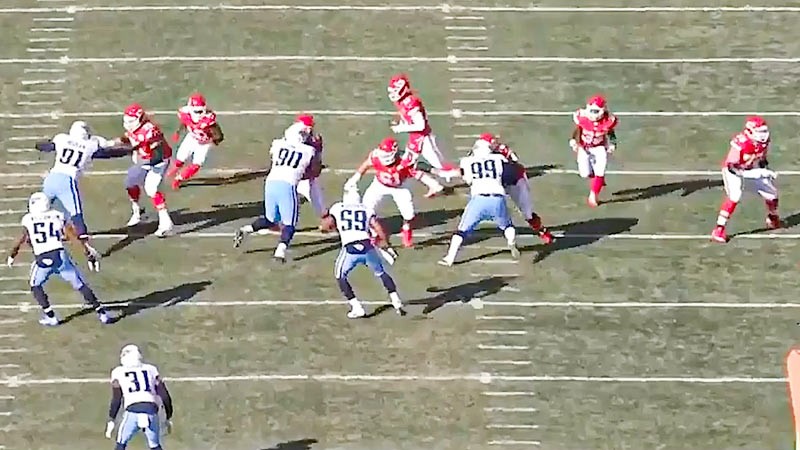American football is a sport defined by its strategic complexity, where every play is meticulously crafted to outwit the opposing team. One such play that embodies this strategic depth is the football draw play.
This play, often referred to simply as the “draw,” is a tactical maneuver that adds an element of surprise to an offense’s arsenal.
In this blog post, we delve into the nuances of the football draw play, understanding its purpose, execution, and impact on the field. So, stay focused.
What Is Football Draw Play?
A football draw play, also known as a draw, is a deceptive maneuver in American football. It is designed to confuse the defense by initially simulating a passing play but then transitioning into a running play.
Unlike play-action passes, which feign a running play but lead to a pass, draw plays begin with the intention of appearing as passes to catch the defense off guard.
This tactical approach is often employed during long-yardage situations when the defense is anticipating a pass. The quarterback drops back as if preparing to throw, while the offensive line creates the illusion of pass protection.
Simultaneously, a running back takes advantage of the defense’s focus on pass coverage to receive a handoff and advance through gaps in the defensive line. The draw play aims to exploit the element of surprise, potentially resulting in substantial yardage gains.
When to Use Draw Play in American Football?
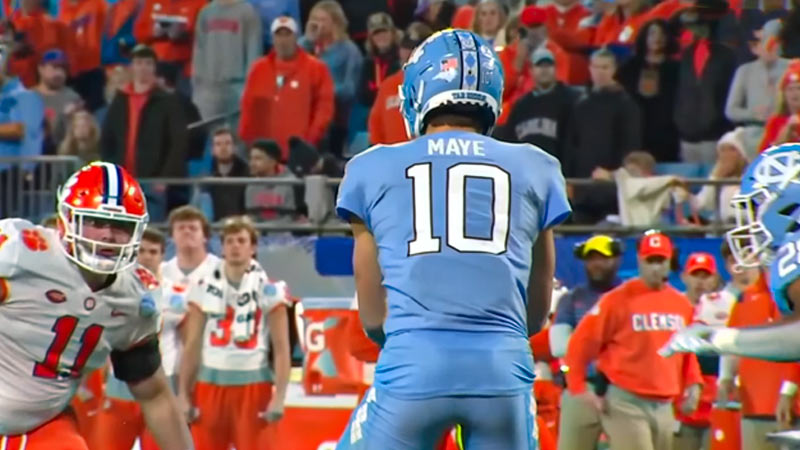
A draw play is strategically employed in specific situations during an American football game to capitalize on the element of surprise and take advantage of the defensive alignment. Here are some instances when teams might consider using a draw play:
Long-Yardage Situations
Draw plays are commonly utilized in situations where the offense needs to cover a significant distance to achieve a first down or a touchdown. The defense often expects a passing play in these scenarios, making the draw play effective by catching defenders out of position.
Predictable Passing Downs
On obvious passing downs, such as third-and-long, the defense is geared up to rush the passer. Using a draw play can exploit the aggressive pass rush and create running lanes for the ball carrier.
Against Aggressive Defenses
Draw plays can be especially effective against defenses known for their aggressive pass rush or blitzing tendencies. By using a draw, the offense can take advantage of the defense’s eagerness to rush the quarterback and create open running lanes.
Setting Up Play-Action
Employing draw plays strategically can set up future play-action passes. If the defense becomes wary of the draw play, they might hesitate to fully commit to stopping the run, creating opportunities for successful play-action passes.
Running Out the Clock
In situations where the team has a lead and wants to consume time on the clock, a draw play can be used to keep the ball on the ground, eat up time, and minimize the risk of turnovers that passing plays might entail.
Mixing Up Playcalling
Varying playcalling keeps the defense guessing. Incorporating draw plays alongside passing plays and traditional running plays adds unpredictability and can lead to better offensive balance.
It’s important for coaches and quarterbacks to assess the defensive alignment, the game situation, and the tendencies of the opposing team when deciding to use a draw play.
Players’ Role in Football Draw Play
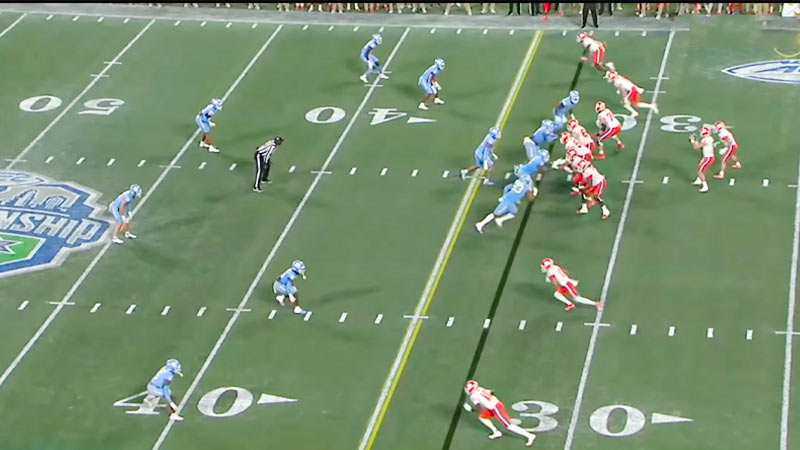
In a football draw play, various players on the offensive side of the ball have specific roles to execute the play effectively.
Each player’s contribution is crucial in creating the illusion of a passing play while executing a successful running play. Here are the key players and their roles in a typical draw play:
Quarterback (QB)
The quarterback’s role is to simulate a passing play by taking a drop-back stance and acting as if they are about to throw a pass. The QB’s fake motion is aimed at drawing the attention of the defensive players, particularly the linebackers and secondary, away from the running back and the line of scrimmage.
Offensive Line
The offensive linemen play a crucial role in making the draw play convincing. They block as if they are protecting the quarterback during a passing play, effectively engaging the defensive linemen and maintaining their pass protection stance.
This creates a split-second delay in the defensive linemen’s ability to react to the running play, providing the running back with an opportunity to exploit gaps in the defense.
Running Back (RB)
The running back’s role is central to the draw play’s success. The RB must read the blocking of the offensive line and the movement of the defensive players.
After receiving the handoff from the quarterback, the RB should quickly identify a running lane that has opened up due to the hesitation of the defensive linemen. The RB’s agility, vision, and acceleration are critical in exploiting the gaps for positive yardage.
Wide Receivers (WR) and Tight Ends (TE)
The wide receivers and tight ends contribute to the play by running routes that mimic a typical passing play. Their actions help to keep the defensive backs occupied and prevent them from committing fully to defending against the run.
This spacing can also create additional gaps in the defensive coverage that the running back can exploit.
Center
The center is responsible for snapping the ball to the quarterback and then blocking the defensive lineman in front of them. Their initial snap and blocking action help in disguising the play’s intent and contribute to the overall deception.
Guards and Tackles
The guards and tackles from the offensive line and are essential in creating the illusion of pass protection. They engage the defensive linemen, keep them occupied, and delay their reaction to the running play.
Impact of Draw Play
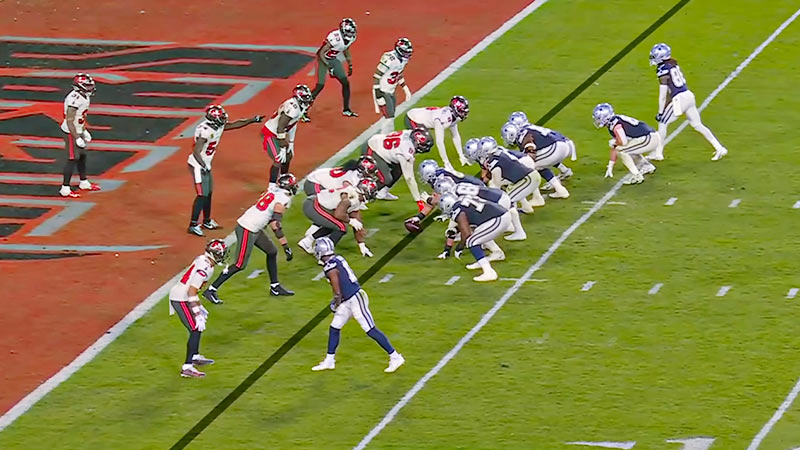
The draw play in American football can have several impactful outcomes that benefit the offensive team if executed successfully:
Surprise Factor
The primary advantage of a draw play is the element of surprise. By initially simulating a passing play, the draw play catches the defense off guard, often leading to defensive players being out of position. This surprise factor can result in significant yardage gains for the offense.
Exploiting Aggressive Defenses
Draw plays are particularly effective against defenses that aggressively rush the quarterback, anticipating a pass play. The offensive line’s pass-blocking stance creates openings for the running back to exploit as defensive linemen and linebackers overcommit to the pass rush.
Yardage Gains
If the running back can find a seam in the defensive line and exploit it quickly, the draw play can lead to substantial yardage gains. The momentary hesitation caused by the pass-like setup gives the running back extra time to identify and hit the gaps.
Reducing Turnovers
Since draw plays are designed to keep the ball on the ground, there is a reduced risk of turnovers compared to passing plays. This can be advantageous when protecting a lead or in situations where ball security is paramount.
Setting Up Play-Action Passes
Successful execution of draw plays can create a situation where the defense becomes more cautious about rushing the passer. This can set up opportunities for play-action passes, where the quarterback fakes a run before passing. The defense’s uncertainty can create open passing lanes for big gains.
Eating Up Clock
Draw plays can help control the tempo of the game and eat up the clock, especially when the offense has a lead. By keeping the ball on the ground and gaining positive yardage, the offense can limit the opposing team’s opportunities to possess the ball.
Balancing Offensive Strategy
Incorporating draw plays into the offensive playbook adds an additional dimension to the playcalling. This balanced approach keeps the defense guessing and prevents them from keying in solely on the passing or running game.
However, not all draw plays lead to success. If the defense doesn’t react as anticipated, or if the offensive line fails to effectively engage the defensive linemen, the draw play might result in minimal or negative yardage gains.
Advantages of Football Draw Play
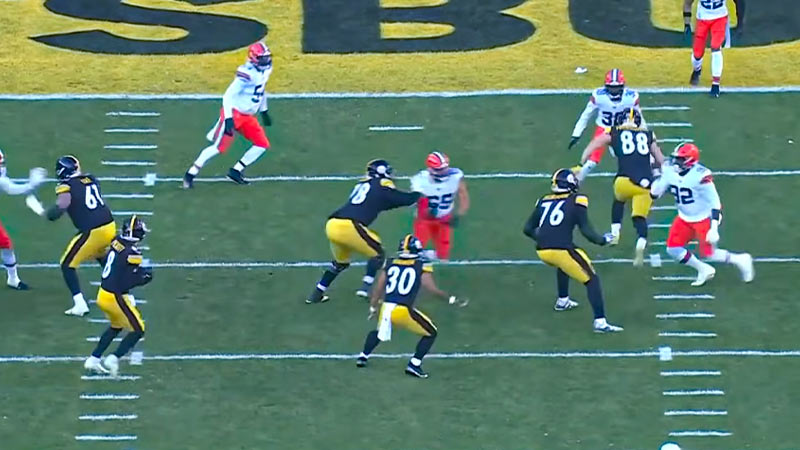
The football draw play offers several advantages to the offensive team when strategically executed:
Element of Surprise
The draw play is designed to deceive the defense by mimicking a passing play. This surprise element catches defenders off guard, leading to confusion and potential openings in the defensive line that the running back can exploit.
Defensive Misdirection
The draw play forces defenders to momentarily hesitate and consider whether it’s a pass or run. This split-second delay can create mismatches in defensive positioning, allowing the offensive line to engage blockers more effectively and providing the running back with better running lanes.
Exploiting Aggressive Defenses
Against defenses known for their aggressive pass rush or blitzing tendencies, the draw play can be particularly effective. As defenders rush to the quarterback, the offensive line’s pass-blocking stance creates gaps for the running back to capitalize on.
Yardage Gains
Successful execution of the draw play can lead to substantial yardage gains. By catching the defense off balance and creating space, the running back has a better chance of breaking through the line of scrimmage for significant yardage.
Reduced Turnover Risk
Draw plays involve handing the ball off to the running back rather than attempting a pass. This reduces the risk of interceptions or fumbles that can occur during passing plays.
Clock Management
In situations where the offensive team has a lead and wants to run down the clock, the draw play can be effective. It keeps the clock running while maintaining possession of the ball and gaining positive yardage.
Setting Up Play-Action Passes
Successfully running draw plays can make the defense more cautious about rushing the quarterback. This sets up opportunities for play-action passes, as defenders become hesitant to rush, creating open passing lanes downfield.
Balancing Offensive Strategy
Incorporating draw plays adds diversity to the offensive playbook. This balanced approach keeps the defense uncertain about the next play, making it harder for them to predict the offensive team’s intentions.
Boosting Offensive Confidence
If the draw play gains significant yardage, it can boost the offensive team’s confidence and momentum, potentially leading to better overall performance.
Controlled Offense
Draw plays provide a controlled and strategic way to move the ball downfield. They can help maintain a deliberate pace, giving the offense more control over the game’s tempo.
Disadvantages of Draw Play
While the football draw play has its advantages, it also comes with certain disadvantages and risks that coaches and teams need to consider:
Predictability
Overusing the draw play can lead to predictability. If the defense starts to recognize the offensive tendencies, they can adjust and react more effectively, minimizing the success of the draw play.
Limited Yardage in Short-Yardage Situations
The draw play is typically more effective in long-yardage situations where the defense is anticipating a pass. In short-yardage situations, where the defense is already playing close to the line of scrimmage, the draw play may not yield significant yardage gains.
Potential for Loss of Yards
If the defensive line reads the draw play and reacts quickly, it can result in negative yardage or a loss of yards for the offense. This is especially true if the offensive line fails to engage the defensive linemen effectively.
Lack of Passing Threat
Running the draw play too often can lead to a lack of passing threat. Defenses might eventually adjust by playing closer to the line of scrimmage, making it harder to successfully execute passing plays.
Dependency on Defensive Reaction
The success of the draw play heavily depends on the defense reacting as anticipated. If the defense doesn’t buy into the fake pass setup, the play might not be as effective.
Reduced Passing Opportunities
Running draw plays too frequently can limit the number of passing opportunities for the offense. This can hinder offensive balance and potentially make the offense one-dimensional.
Ineffective Against Strong Run Stoppers
If the opposing defense has strong run-stopping defensive linemen and linebackers, the draw play might struggle to generate positive yardage.
Time-Consuming Setup
The setup for the draw play can be time-consuming. The quarterback needs to drop back as if preparing to pass, and the offensive linemen must hold their pass-blocking positions before transitioning to run-blocking. This extra time can allow the defense to react and minimize the play’s impact.
FAQs
What is a football draw play, and how does it work?
The football draw play is a running play disguised as a passing play. It aims to catch the defense off guard by simulating a pass, luring defenders into coverage, and creating running lanes for the ball carrier.
The quarterback drops back as if preparing to throw, while the offensive line sets up for pass protection. Simultaneously, the running back receives a handoff and capitalizes on the defense’s hesitation.
When is the draw play typically used?
Draw plays are often employed in long-yardage situations, where the defense anticipates a pass. They are also effective against aggressive defenses with strong pass rushes. The element of surprise can lead to substantial yardage gains and set up future play-action passes.
What advantages does the draw play offer?
The draw play provides the element of surprise, misdirection, and the potential to exploit aggressive defenses. It can yield significant yardage gains, control the clock, and reduce the risk of turnovers compared to passing plays. Successful draw plays can also set up opportunities for other offensive strategies.
Are there any risks associated with the draw play?
Overusing the draw play can lead to predictability, diminishing its effectiveness. Additionally, if the defense reads the play quickly, it can result in negative yardage. Draw plays might limit passing opportunities and could be less effective against strong run-stopping defenses.
How important is timing in executing a successful draw play?
Timing is paramount for a successful draw play. The quarterback’s deception, the offensive line’s pass-blocking stance, and the running back’s quick decision-making need to synchronize perfectly. A well-timed draw play capitalizes on the defense’s reaction and creates optimal running lanes.
Wrapping Up
The football draw play stands as a testament to the strategic intricacies of American football. Its ability to deceive, surprise, and create opportunities on the field showcases the depth of thought behind every play call.
As we’ve explored the FAQs surrounding the football draw play, it’s evident that its advantages and disadvantages hinge on a delicate balance of execution and innovation.
When employed wisely, the draw play can be a game-changing element that keeps both players and fans on the edge of their seats. Thank you for your time.

